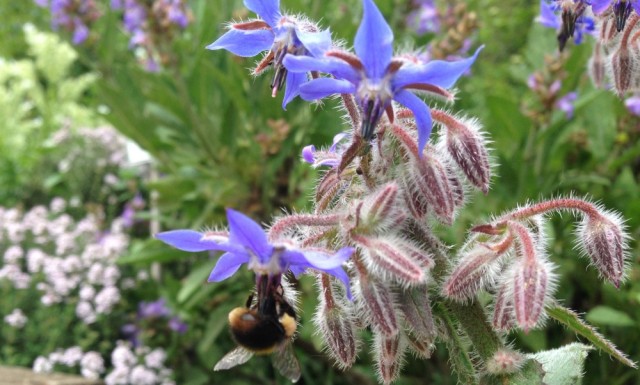A couple of weeks ago I had a rare mid-week evening trip out. Colours Cafe, a local Truro cafe which holds regular events inspired by nature, wellbeing and good food, was hosting a talk on growing wildflower meadows by a local gardener and meadow consultant called Elly Phillips.
The talk was fascinating though sadly I was the only audience member there! Perhaps because not many people in Truro (myself included) have space to grow a wildflower meadow; however Elly’s tips are suitable for borders or small pots of wildflowers too. Since her talk I’ve sown the seeds she gave me, but unfortunately we’ve had a surprise second snow fall since then, so I’m not sure whether they’ll have survived that.
The importance of poor soil
Wildflowers like poor nutrient soil. If the ground has been fertilised in the past and now has grass growing there, then cutting and removing the grass is a good way to remove nutrients from it. You can also plant brassica vegetables like Brussel sprouts, cabbages or broccoli to deplete the soil, as they will suck up all the nutrients as they grow.
Know your soil
Have a look at local verges around you to see what’s growing naturally. Feel your soil to test whether it feels sticky and clumpy like clay or is more fine and sandy. This will help you assess what plants will appreciate your particular soil. You can also get acidity kits to test your soil’s pH levels. If you really want to take it seriously, the RHS has a soil analysis service which currently costs £30.
If you see slate rocks in your soil, that is a clue that your soil is likely to contain clay. If you see granite, that is a clue that your soil is likely to contain peat.
Some wildflowers, like Birds foot trefoil and yarrow, are forgiving of most soils.
What, where and when…
Snowdrops can be planted in spring – buy ‘in the green’ when bulbs are fresh. Crocuses can be planted in autumn. Garden centres tend to put cornflower and poppy seeds in wildflower mixes – these look very pretty but are only suitable for annually agitated soil, otherwise they won’t return the next year.
Elly recommends buying seeds and plants from specialist wildflower suppliers rather than garden centres, as they will supply good quality native seeds. Research by Dr Dave Goulson has also shown that many garden centres use pesticides, so by buying their plants you may actually be harming local pollinators – see his June 2017 blog post, Pesticides in ‘Bee-Friendly’ Flowers.
To yellow rattle or not yellow rattle
Apparently this is a common debate when planting a wildflower meadow. Yellow rattle is semi-parasitic and helps to suppress some grasses. It’s an annual, so the seeds need to drop or be harvested before sowing back. You need around 1.5 grams per square metre.
How to sow
You need minimum 50% bare earth to sow into. Scatter the seeds on top of the bare earth. It’s worth putting sand or sawdust into your seed mix so that you can see where you’ve sowed and also because it helps distribute the seeds.
Trample or press the ground down lightly after sowing to stop the seeds blowing away – but seeds don’t survive in compacted ground, so don’t pack the soil down too hard.
Autumn is the best time to sow, as then flowers have time to get a head start, but spring works too.
Aftercare
Year 1 – cut regularly through summer
Year 2 – cut at the end of summer
Note: if you have sown annuals don’t cut between April to July, to allow them to flower.
You must remove the cuttings! Otherwise they will release nutrients back into the soil, which is bad for wildflowers.
Links
Here’s some seed suppliers/wildflower experts which Elly recommended:
- www.meadowsweet.uk – Elly’s consultancy business, she is based in Cornwall and can come out to your garden or land to give advice on planting a wildflower meadow or encouraging wildlife and pollinators.
- www.thewildflowersociety.com – The Wild Flower Society is a UK national society for amateur botanists and wild flower lovers
- www.growwilduk.com – Grow Wild provides free advice on growing wildflowers
- https://beehappyplants.co.uk – a small family business which provides organic seeds and plants. Their website has advice on the best plants for various soil types.



It’s a pity more people weren’t at the talk. “Plant more wildflowers!” is my chant lately so I hope yours grow. I sowed a bunch of plugs last fall that I will grow on a bit before transplanting into some renovated areas this year. Gotta feed our little six-legged friends!
LikeLiked by 1 person
Ooh good luck with your plugs!
LikeLiked by 1 person
Thank you, Emily. I hope to do some of this in the coming months, not planting a meadow but want to remove nutrients and leave space for the “weeds” to grow. I stripped off the grass in my apiary and that has become a great source of meadow-like flowers. Hopefully to start harvesting the grass and create more meadow friendly areas. A very timely post – appreciate it.
LikeLiked by 1 person
Show us some photos once it gets going, I love how “weeds” look.
LikeLiked by 1 person
Good advice. I have found that seed scatter rarely works here, must be all the birds. But I have recently had a patch of garden open up that I might try again, that or plant more country-gardenish tall plants….
LikeLiked by 1 person
Foxgloves maybe? They’re so pretty.
LikeLiked by 1 person
I am looking into those. I have a real hankering for cornflowers…
LikeLiked by 2 people